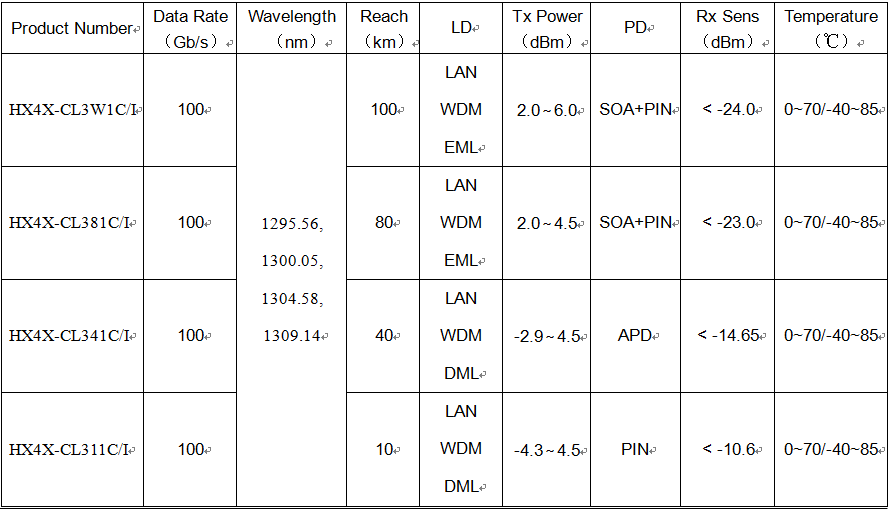

 Industry Dynamic +
Industry Dynamic +  2023.11.20
2023.11.2040G optical module plays a key role in high-speed networks. It is a fiber optic communication device used to transmit data, with high-speed data transmission capabilities, widely used in data centers, telecom operators, enterprise networks and other fields. In this article, let's take a look at how the 40G optical module plays its role in high-speed networks!
First, recognize 40G optical module
To realize 40G data transmission, QSFP+ optical modules are usually used.QSFP+ (Quad Small Form-factor Pluggable) four-channel small, hot-swappable optical modules support high-density deployments and are capable of transmitting multiple channels at the same time to achieve 40Gbps data transmission.
40G optical modules typically support multiple interface standards such as 40G BASE-SR4/BIDI SR/SWDM4/PSM4/LR4/ER4/ZR4. This compatibility enables 40G optical modules to seamlessly integrate with network equipment from different vendors to provide, high-speed, reliable data transmission.

Second, 40G optical modules in high-speed network applications
Can realize high-speed data transmission: as we all know in the high-speed network, the need for fast, efficient transmission of large amounts of data, 40G optical modules can be 40Gbps rate of data transmission to meet this demand, to provide high-speed data transmission capabilities.
Can provide bandwidth demand: With the development of the information age, we use more and more tools, while the continuous growth of data volume, the network demand for bandwidth is also increasing. 40G optical module can provide great support for high bandwidth, to meet the network of large amounts of data streams in the transmission needs to ensure that the network's throughput and data processing capacity for our work, life and other transmission scenarios to protect.

Can meet the development trend of emerging technologies: the rise of cloud computing, big data and artificial intelligence and other fields, the demand for network transmission speed and bandwidth is also gradually increased. 40G optical module as a high-speed optical communication technology, to meet the requirements of these emerging applications on data transmission, become an important part of high-speed network.
With the ability to optimize network topology: In addition to the above three advantages, 40G optical module in the optimization of network topology is also emerging, it can optimize the topology in the network, reduce the number of transmission paths and devices, improve network efficiency and performance. It can also be used to connect data centers, server clusters, switches, routers and other network equipment to build high-speed, reliable data transmission channels.
In summary, 40G is a high-speed data transmission technology for applications requiring high bandwidth and large-capacity data transmission. It plays an important role in data centers, telecommunication carriers and enterprise networks, and has compatibility and deployment flexibility.
Q&A
1、What is 400G QSFP-DD optical module?
A: 400G optical module refers to the optical module products whose transmission rate reaches 400Gbps. Currently the mainstream packaging type is QSFP-DD and OSFP, QSFP-DD is a high-speed optical module interface specification, the upgraded version of the QSFP interface, support for 400G high-speed transmission. Using optical fiber as the signal transmission medium, by converting electrical signals into optical signals and transmitting them in the optical fiber.
2、What are the common types of 400G QSFP-DD optical modules in the market?
A: The common 400G QSFP-DD optical modules in the market have the following types in the market: QSFP-DD SR8, QSFP-DD DR4, QSFP-DD FR4, QSFP-DD FR8, QSFP-DD LR4, QSFP-DD LR8 and QSFP-DD ER8 optical modules.
3、What is the difference between QSFP-DD and OSFP optical modules?
A: QSFP-DD is smaller in size and more suitable for data center applications, which is the mainstream development direction, while OSFP is slightly larger in package size and consumes more power, which is more suitable for telecom applications. In contrast, the QSFP-DD interface provides four-channel small size and double the port density, OSFP for the eight high-speed electrical channels, the current view of the QSFP-DD good compatibility and perfect support for 400G is still the preferred choice in the market.
Subscribe to the newsletter
for all the latest updates.
2-5# Building, Tongfuyu Industrial Zone, Aiqun Road, Shiyan Street, Baoan District, Shenzhen. China
